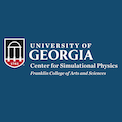Events Calendar View
-
Special Colloquium
Sep 18, 2015
NASA Ames CubeSat Missions: A Short History of Nearly Everything and a Glimpse of the Future

Guest: Jasper Wolfe, Roberto Carlino, and Roger Hunter, NASA Ames Research Center
Friday, September 18, 2015 3:30 pm - 4:30 pm
Location: Physics Auditorium (202)NASA Ames Research Center has been a leading NASA advocate for CubeSat for a number of years, conducting a spectrum of missions including astrobiology (Pharma-Sat) to innovative low cost technology demonstrations, such as PhoneSat. Through the successful flights of dozens of these nanonsatellites from Ames, many lessons have been learned, discoveries made, technologies demonstrated, and paradigms shifted. This presentation will cover a "short history of nearly everything" to do with Ames CubeSats and how to get involved. We will include a brief view of the Cube-Sat event horizon and beyond. -
CSP Lunch Seminar
Sep 22, 2015
Streamlined Charge Exchange Calculations for Cometary X-ray Emission Modeling

Guest: Patrick Mullen, UGA Physics and Astronomy
Tuesday, September 22, 2015 12:30 pm - 1:30 pm
Location: CSP Conference Room (322) -
CSP Lunch Seminar
Sep 29, 2015
A Simulational Study of Molecular Hydrogen Formation in the ISM

Guest: John Dupuy, UGA Center for Simulational Physics
Tuesday, September 29, 2015 12:30 pm - 1:30 pm
Location: CSP Conference Room (322) -
Departmental Colloquium
Oct 1, 2015
Calories for Quarks: The Origin of Visible Mass in this Universe
The 2013 Nobel Prize in Physics was awarded to Higgs and Englert following discovery of the Higgs boson at the Large Hadron Collider. With this discovery the Standard Model of Particle Physics became complete. Its formulation and verification are a remarkable story. However, the most important chapter is the least understood. Quantum Chromodynamics (QCD) is that part of the Standard Model which is supposed to describe all of nuclear physics and yet, almost fifty years after the discovery of quarks, we are only just beginning to understand how QCD builds the basic bricks for nuclei: pions, neutrons, protons. Critically, the Higgs boson is often said to give mass to everything. However, that is wrong. It only gives mass to some very simple particles, accounting for only one or two percent of the mass of more complex objects. The vast majority of mass comes from the energy needed to hold quarks together inside nuclei. I will explain this remarkable emergent phenomenon, contained fundamentally in Nambu's share of the 2008 Nobel Prize, and discuss its connection with the peculiar feature of confinement in QCD, /viz/. the fact that quarks are forever imprisoned, never reaching the freedom of a particle detector; and show how contemporary and future terrestrial experiments can help complete the book on the Standard Model. -
Departmental Colloquium
Oct 15, 2015
Functional Oxide Materials Discovery by Epitaxial Design
Complex oxides are known to possess the full spectrum of fascinating properties, including magnetism, colossal magneto-resistance, superconductivity, ferroelectricity, pyroelectricity, piezoelectricity, multiferroicity, ionic conductivity, and more. This breadth of remarkable properties is the consequence of strong coupling between charge, spin, orbital, and lattice symmetry. Spurred by recent advances in the synthesis of such artificial materials at the atomic scale, the physics of oxide heterostructures containing atomically smooth layers of such correlated electron materials with abrupt interfaces is a rapidly growing area. Thus, we have established a growth technique to control complex oxides at the level of unit cell thickness by pulsed laser epitaxy. The atomic-scale growth control enables to assemble the building blocks to a functional system in a programmable manner, yielding many intriguing physical properties that cannot be found in bulk counterparts. In this talk, examples of artificially designed, functional oxide heterostructures will be presented, highlighting the importance of heterostructuring, interfacing, and straining.
The main topics include (1) fast, reversible redox reactions in epitaxial 'SrCoOx oxygen sponges' and their strain control for improved catalytic oxygen reduction reaction, (2) understanding oxygen vacancy stability in layered oxides: brownmillerite and Ruddlesden-Popper oxides, (3) orbital polarization in LaNiO3 thin films for improved oxygen catalysis, (4) improving carrier transport and thermoelectric power of oxide 2D electron gases in LaTiO3/SrTiO3 superlattices by fractional delta doping, and (5) spin-orbit coupling in SrIrO3 thin films and heterostructures.
-
CSP Lunch Seminar
Oct 20, 2015
Universal Pre-Threshold Quantum Simulation and the ABA decomposition

Guest: Amara Katabarwa, UGA Physics and Astronomy
Tuesday, October 20, 2015 12:30 pm - 1:30 pm
Location: CSP Conference Room (322)
Page 61 of 121, showing 6 records out of 723 total, starting on record 361, ending on 366

